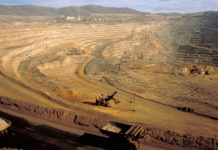
[miningmx.com] — GOLD miners turned to net hedging for just the second time in five years in the first quarter of 2011 but are not expected to make a concerted return to selling their production forward this year, metals consultancy GFMS and Societe Generale said in a quarterly report on Tuesday.
The first quarter saw 0.19 million ounces added to the global hedge book, which stood at 4.88 million ounces at the end of March.
It was the first quarter of net hedging since Q2 2010 and a rare break from consistent de-hedging dating back to the start of 2006.
Swedish producer Boliden was the largest hedger, adding 0.33 million ounces of forward sales in the first quarter.
Hedging involves agreeing to sell future production at a pre-determined price to lock in a guaranteed price for the metal, which is a boon to companies in times of declining gold prices, but can sting a producer in a rising market.
The spot price of gold is near record highs above $1,625 an ounce, having risen by over 15% this year on the back of concern over the impact to the global economy from the European debt crisis, the slowing US economy, unrest in the Middle East and the effect of inflation in China.
The gold price is set for its 11th consecutive annual rise, having more than doubled in the last five years, when the global hedge book accounted for nearly 20 million ounces of production sold forward.
GFMS and SocGen said one of the key differences with the hedging in the first quarter of this year was the use of options contracts – which give their holder the right but not the obligation to deliver material at a pre-determined price and date – as opposed to simple forward sales.
“While the industry as a whole appears to be less vehemently opposed to hedging than was the case a couple of years ago, we note that most hedging is still being undertaken over a short to medium timeframe: little hedge cover extends beyond 2013,” the report said.
GFMS and SocGen added that Boliden, Japan’s Sumitomo and Mexico’s Penoles accounted for the bulk of any longer-term hedging.
The report showed that the delivery schedule of the hedge book indicated that in 2011 there are 0.78 million ounces of forward sales and 0.24 million ounces of options positions against which delta-hedging will be closed by end-year.
HEDGE BOOK SHRINKS
GFMS and SocGen said given the size and composition of the hedge book, they have revised their estimate for net de-hedging for 2011, to forecast 0.80 million ounces of de-hedging, leaving the total book at 3.88 million ounces, or 121 tonnes, at end-December 2011, compared with 4.86 million ounces last December.
Last year AngloGold Ashanti [JSE:ANG], the world’s third biggest gold miner, closed out the last of the large hedge books, buying back some 1.33 million ounces in the final three months of 2010.
The only major producer to engage in de-hedging in the first quarter of this year was Canada’s Kinross Gold Corp , which bought back the last of its outstanding hedge contracts dating from its purchase of Bema Gold, removing 0.09 million ounces from the market, the report said.
Mexican miner Minera Frisco was one of the producers whose bottom line suffered as a result of the hedges it put in place earlier in the year, when it hedged most of its production through 2013 and 2014 but locked in prices below the rallying commodities markets, missing out on bigger profits.









